Mercedes E-Class Wagon vs VW Tayron – Which car suits you better?
Both models have their strengths – but which one suits you more?
Compare performance, efficiency, price and space directly: Mercedes E-Class Wagon or VW Tayron?
Costs and Efficiency:
Price and efficiency are key factors when choosing a car – and this is often where the real differences emerge.
VW Tayron has a noticeable advantage in terms of price – it starts at 39000 £, while the Mercedes E-Class Wagon costs 52600 £. That’s a price difference of around 13654 £.
Fuel consumption also shows a difference: VW Tayron manages with 0.40 L and is therefore convincingly more efficient than the Mercedes E-Class Wagon with 1.70 L. The difference is about 1.30 L per 100 km.
As for range, the VW Tayron performs somewhat better – achieving up to 126 km, about 17 km more than the Mercedes E-Class Wagon.
Engine and Performance:
Power, torque and acceleration say a lot about how a car feels on the road. This is where you see which model delivers more driving dynamics.
When it comes to engine power, the Mercedes E-Class Wagon has a clearly edge – offering 585 HP compared to 272 HP. That’s roughly 313 HP more horsepower.
In acceleration from 0 to 100 km/h, the Mercedes E-Class Wagon is clearly quicker – completing the sprint in 4.10 s, while the VW Tayron takes 6.10 s. That’s about 2 s faster.
In terms of top speed, the Mercedes E-Class Wagon performs slight better – reaching 250 km/h, while the VW Tayron tops out at 240 km/h. The difference is around 10 km/h.
There’s also a difference in torque: Mercedes E-Class Wagon pulls decisively stronger with 750 Nm compared to 400 Nm. That’s about 350 Nm difference.
Space and Everyday Use:
Cabin size, boot volume and payload all play a role in everyday practicality. Here, comfort and flexibility make the difference.
Both vehicles offer seating for 5 people.
In curb weight, VW Tayron is to a small extent lighter – 1682 kg compared to 1900 kg. The difference is around 218 kg.
In terms of boot space, the VW Tayron offers clearly perceptible more room – 885 L compared to 615 L. That’s a difference of about 270 L.
In maximum load capacity, the VW Tayron performs to a small extent better – up to 2090 L, which is about 260 L more than the Mercedes E-Class Wagon.
When it comes to payload, Mercedes E-Class Wagon to a small extent takes the win – 645 kg compared to 566 kg. That’s a difference of about 79 kg.
Who comes out on top?
Overall, the VW Tayron shows itself to be wins the duel decisively and secures the title of DriveDuel Champion.
It convinces with the more balanced overall package and proves to be the more versatile choice for everyday use.
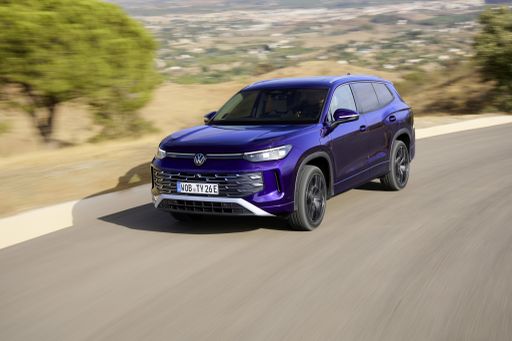
VW Tayron
Mercedes E-Class Wagon
The Mercedes-Benz E-Class Wagon offers a harmonious blend of luxury and practicality, making it a favourite for those who value both style and functionality. Its sleek exterior design is matched by a sophisticated interior that provides a comfortable and spacious environment for both driver and passengers. This vehicle also boasts advanced technology features, ensuring a smooth and connected driving experience.
details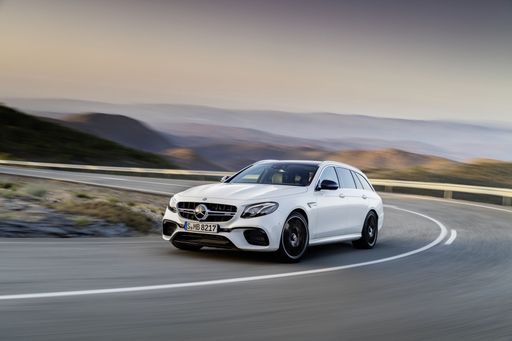 @ group-media.mercedes-benz.com
@ group-media.mercedes-benz.com
 @ group-media.mercedes-benz.com
@ group-media.mercedes-benz.com
 @ group-media.mercedes-benz.com
@ group-media.mercedes-benz.com
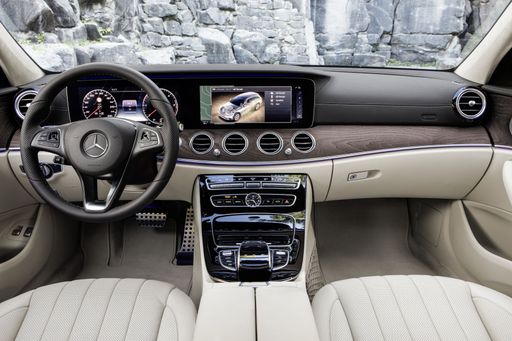 @ group-media.mercedes-benz.com
@ group-media.mercedes-benz.com
VW Tayron
The Tayron stands out as a stylish and versatile SUV that expertly blends form and function. With its spacious interior and modern design, it caters to families and adventure seekers alike, making every journey enjoyable. Equipped with advanced technology and safety features, the Tayron promises a driving experience that is both secure and exhilarating.
details @ volkswagen-newsroom.com
@ volkswagen-newsroom.com
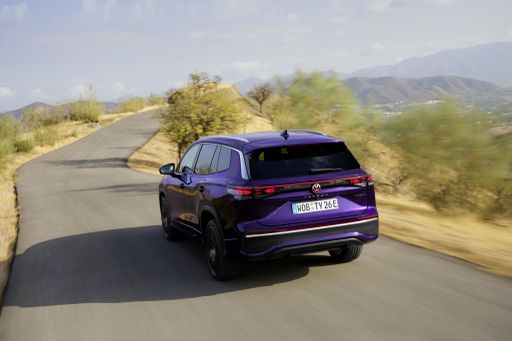 @ volkswagen-newsroom.com
@ volkswagen-newsroom.com
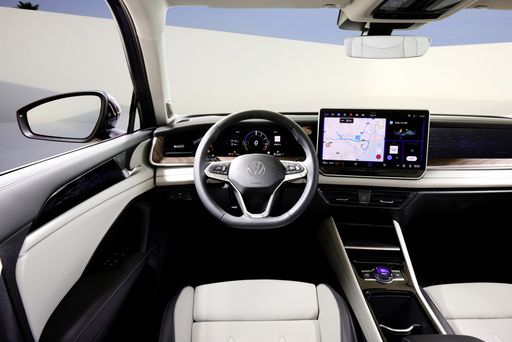 @ volkswagen-newsroom.com
@ volkswagen-newsroom.com
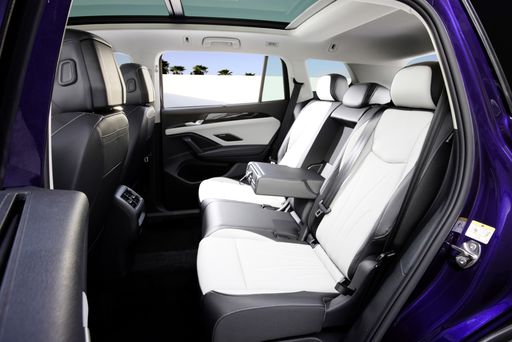 @ volkswagen-newsroom.com
@ volkswagen-newsroom.com

|

|
|
|
|
Costs and Consumption |
|
|---|---|
|
Price
52600 - 121800 £
|
Price
39000 - 52600 £
|
|
Consumption L/100km
1.7 - 7.9 L
|
Consumption L/100km
0.4 - 8.5 L
|
|
Consumption kWh/100km
-
|
Consumption kWh/100km
-
|
|
Electric Range
97 - 109 km
|
Electric Range
117 - 126 km
|
|
Battery Capacity
21.20 kWh
|
Battery Capacity
19.70 kWh
|
|
co2
44 - 181 g/km
|
co2
9 - 192 g/km
|
|
Fuel tank capacity
50 - 66 L
|
Fuel tank capacity
45 - 58 L
|
Dimensions and Body |
|
|---|---|
|
Body Type
Estate
|
Body Type
SUV
|
|
Seats
5
|
Seats
5
|
|
Doors
5
|
Doors
5
|
|
Curb weight
1900 - 2435 kg
|
Curb weight
1682 - 1948 kg
|
|
Trunk capacity
460 - 615 L
|
Trunk capacity
705 - 885 L
|
|
Length
4949 - 4959 mm
|
Length
4792 mm
|
|
Width
1880 mm
|
Width
1853 - 1866 mm
|
|
Height
1469 - 1497 mm
|
Height
1666 - 1668 mm
|
|
Max trunk capacity
1675 - 1830 L
|
Max trunk capacity
1915 - 2090 L
|
|
Payload
540 - 645 kg
|
Payload
489 - 566 kg
|
Engine and Performance |
|
|---|---|
|
Engine Type
Petrol MHEV, Plugin Hybrid, Diesel MHEV
|
Engine Type
Petrol MHEV, Plugin Hybrid, Diesel, Petrol
|
|
Transmission
Automatic
|
Transmission
Automatic
|
|
Transmission Detail
Automatic Gearbox
|
Transmission Detail
Dual-Clutch Automatic
|
|
Drive Type
All-Wheel Drive, Rear-Wheel Drive
|
Drive Type
Front-Wheel Drive, All-Wheel Drive
|
|
Power HP
186 - 585 HP
|
Power HP
150 - 272 HP
|
|
Acceleration 0-100km/h
4.1 - 8.8 s
|
Acceleration 0-100km/h
6.1 - 9.7 s
|
|
Max Speed
213 - 250 km/h
|
Max Speed
204 - 240 km/h
|
|
Torque
320 - 750 Nm
|
Torque
250 - 400 Nm
|
|
Number of Cylinders
4 - 6
|
Number of Cylinders
4
|
|
Power kW
137 - 430 kW
|
Power kW
110 - 200 kW
|
|
Engine capacity
1993 - 2999 cm3
|
Engine capacity
1498 - 1984 cm3
|
General |
|
|---|---|
|
Model Year
2024 - 2025
|
Model Year
2025
|
|
CO2 Efficiency Class
G, E, F, B, D
|
CO2 Efficiency Class
E, B, F, G
|
|
Brand
Mercedes-Benz
|
Brand
VW
|
What drivetrain options does the Mercedes E-Class Wagon have?
The Mercedes E-Class Wagon is offered with All-Wheel Drive or Rear-Wheel Drive.
The prices and data displayed are estimates based on German list prices and may vary by country. This information is not legally binding.
